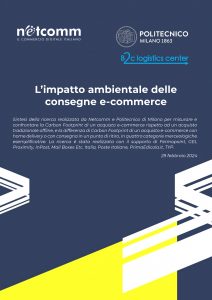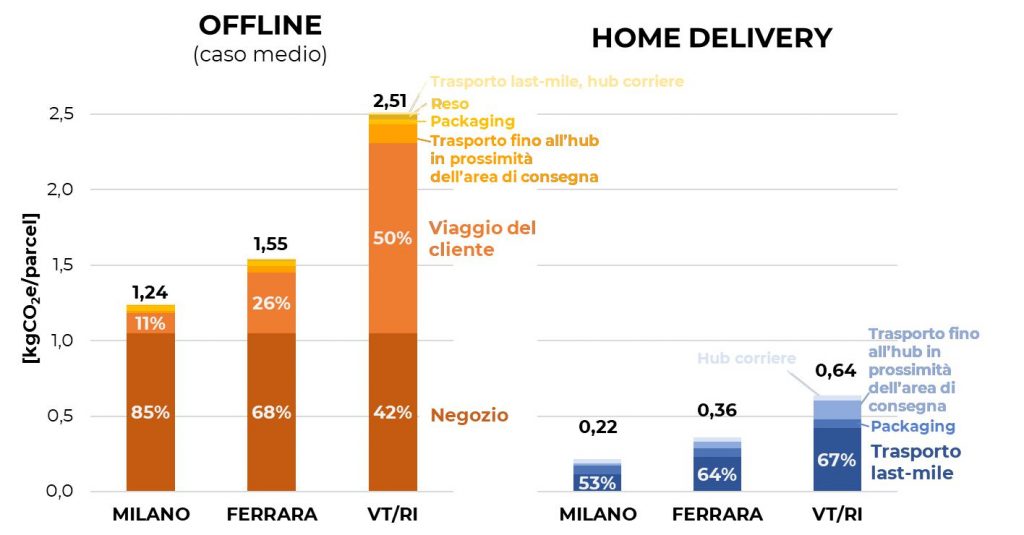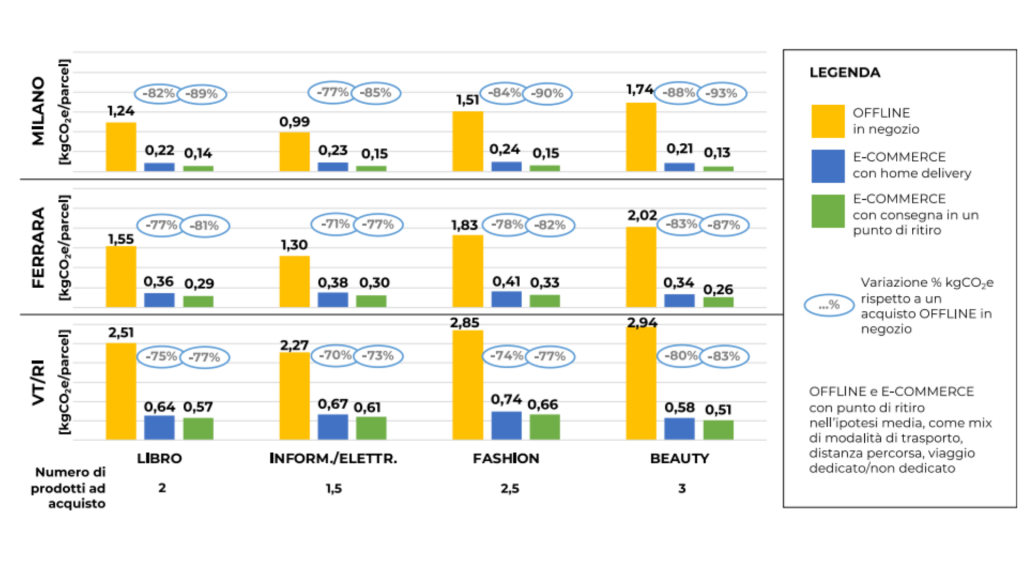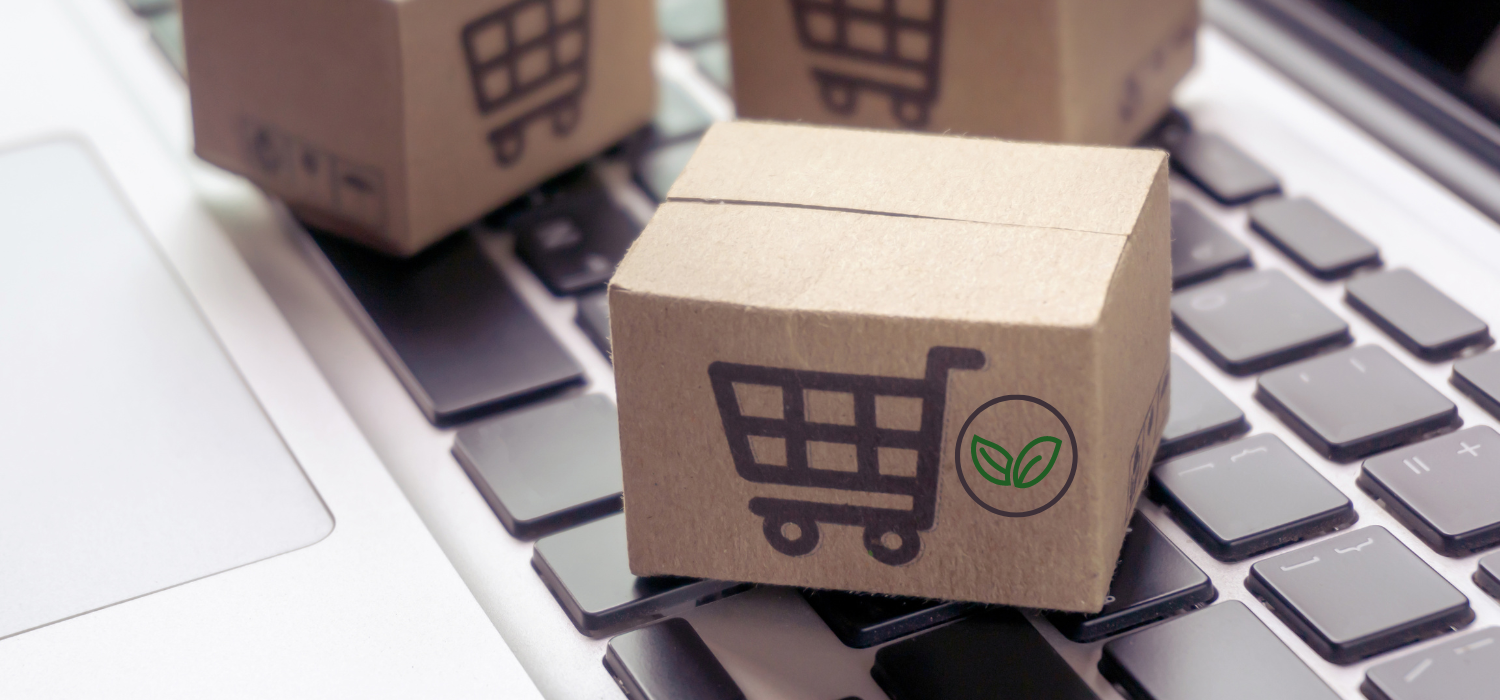In recent years, the environmental impact of eCommerce has been widely debated, most often branding it as unsustainable. Today we tell a different story.
The premise is as follows: there is no doubt that e-commerce has posed new challenges, especially to logistics and especially to last-mile delivery, i.e. the last stretch of the logistical process (i.e. the delivery of the parcel to the end consumer); but it is equally true that these challenges have led to the spread of new solutions, more sustainable even than physical shops.
The protagonist of this story is therefore Out Of Home delivery, i.e. the possibility of picking up an online order – or making a return – outside the home, at a Pick-up Point or Locker. A more sustainable alternative to traditional home delivery and, twist of fate, even traditional shopping at a retail outlet.
The Netcomm – Politecnico di Milano research

This is demonstrated by the results of the research ‘The Environmental Impact of eCommerce Deliveries’ carried out by Netcomm and Politecnico di Milano to measure and compare the Carbon Footprint of an eCommerce purchase compared to a traditional offline purchase, and the difference in Carbon Footprint of an eCommerce purchase with home delivery or with delivery to a Pick-up Point.
Four product categories were analysed: Fashion, Beauty, Books, Computers & Electronics.
Three scenarios were then considered – best, medium and worst, depending on the means used by customers to go to a shop or point of sale, and last-mile delivery rounds, defined by the distance travelled and the number of stops, in the case of home delivery – in three different urban contexts with different population densities. The cities taken as reference were Milan, Ravenna and Viterbo/Rieti.
The research, conducted from September 2023 with the support of GEL Proximity, Fermopoint, InPost, Mail Boxes Etc. Italia, Poste Italiane, PrimaEdicola.it and TYP., is therefore based on a quantitative analytical model that has led to interesting results, to say the least.
The environmental impact of eCommerce is lower than traditional shopping
We promised you a different story. Contrary to the good rules of storytelling, let’s start with the ending: eCommerce is more sustainable than in-store shopping.
The environmental impact of online shopping is in fact lower than that of traditional offline shopping, with reductions ranging from 70-80%.
The reason is simple: with eCommerce, the CO2e components of the shop and the customer’s journey to and from the shop are eliminated.
Offline vs. Home delivery
If we take the product category Book as an example, we then find that ‘the impact of a purchase through the offline channel is significantly higher than the impact of a purchase through the e-commerce channel with Home Delivery. This is true even in the best case for offline, where the impact of the customer’s journey to a shop is nil’.
Let’s give some numbers: in Milan the emissions of the offline process are about 5 times those of Home Delivery, in Ferrara about 3 and in Viterbo/Rieti about 2.

Impatto ambientale acquisto offline nel caso medio e acquisto e-commerce con home delivery (Libro). Fonte immagine: Netcomm – Politecnico di Milano, “L’impatto ambientale delle consegne e-commerce”
For offline, the shop and the customer journey are responsible for most of the environmental impact, with 90% of the total emissions. For home delivery, on the other hand, last-mile transport is the main contributor.
Home delivery vs. Out Of Home delivery
The situation becomes even more interesting when comparing the emissions generated by an e-commerce purchase with home delivery and with delivery to a Collection Point.
In the best case, the emissions of a Point of Collection delivery – strongly influenced by the way the customer picks up the order – are about half of the emissions of a delivery to the customer’s home.

Impatto ambientale acquisto e-commerce con home delivery e acquisto e-commerce con punti di ritiro nel caso medio (Libro). Fonte immagine: Netcomm – Politecnico di Milano, “L’impatto ambientale delle consegne e-commerce”
This is also true for the other product categories analysed.

Sintesi impatto ambientale acquisto offline, acquisto e-commerce con home delivery e acquisto e-commerce con punti di ritiro a Milano, Ferrara e nelle province di Viterbo e Rieti. Fonte immagine: Netcomm – Politecnico di Milano, “L’impatto ambientale delle consegne e-commerce”
Out Of Home deliveries make e-commerce more sustainable
So what is the moral of the story? Not only is eCommerce more sustainable than in-store shopping, but delivery via Pick-up Points is more sustainable than Home Delivery.
Quoting a well-known trend, we could say: are we surprised? We are not surprised. But finally this statement is supported by hard data.
However, allow us one final consideration. Quoting the research, ‘if we want to try to improve the environmental sustainability of the purchasing process, we must empower the customer to make informed and conscious choices. Environmental sustainability is therefore a goal to be pursued through the joint efforts of all parties involved: retailers and logistics providers (with alternative delivery solutions to the traditional one), municipalities and public authorities (both through cultural and political action and by providing infrastructure and public land to support the diffusion of more sustainable solutions) and customers (through conscious and attentive purchasing behaviour – and collection of their parcels)’.
This brings us to a substantial point: how to immediately offer customers the possibility of picking up their online orders at Locker and Pick-up Points.
How to integrate Lockers and Pick-up Points to your e-commerce
The answer is: thanks to GEL Proximity!
In fact, our Network consists of more than 200,000 Collection Points. You can then easily build and manage your customised Network by merging Click & Collect services with third-party Proximity Points, thanks to a single integration.
You can connect GEL Proximity using our dedicated libraries and APIs, or by downloading the module/plugin from the marketplace of your eCommerce software.
GEL Proximity is a Pay-per-Ship service, i.e. you only pay for what is actually shipped when the customer has chosen the pick-up option at a Locker or Pick-up Point.
Help make eCommerce sustainable: activate your GEL Proximity account now.








